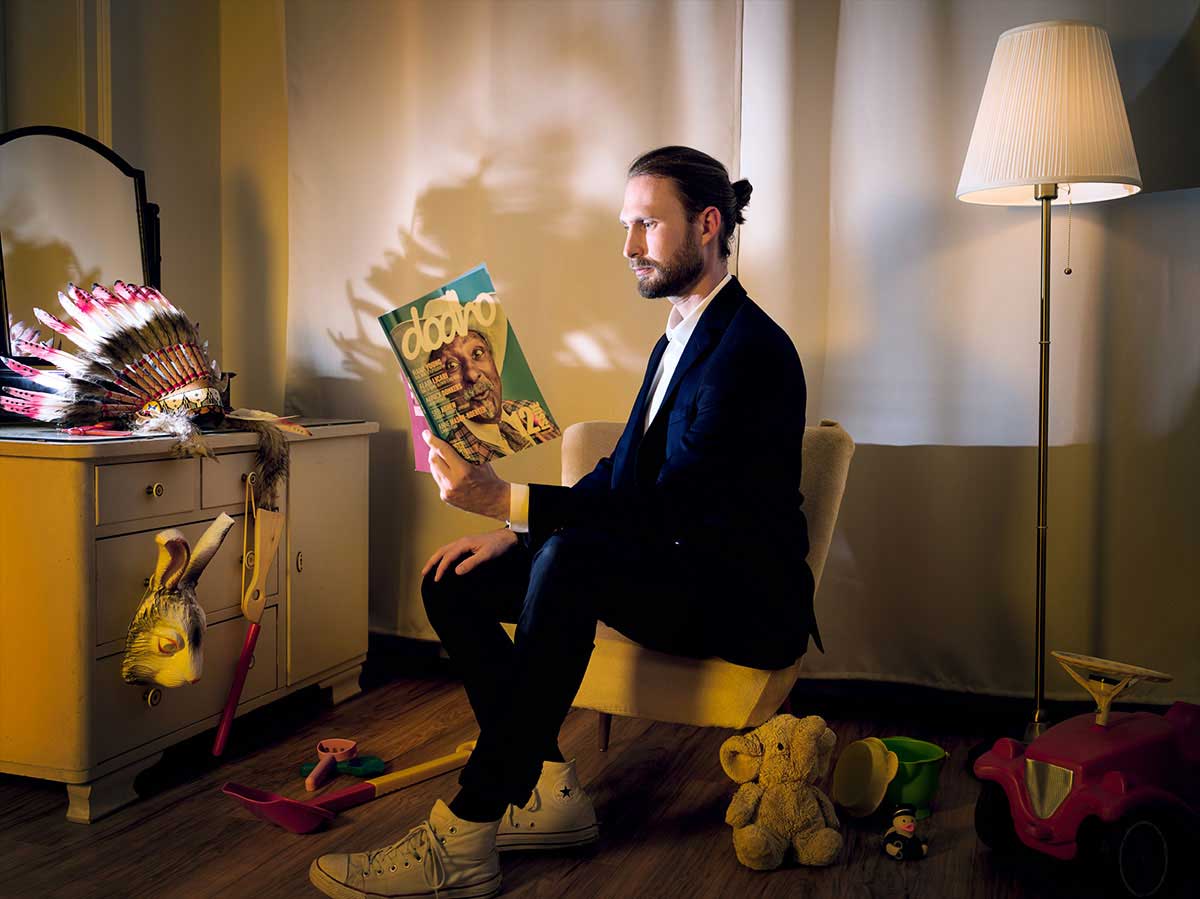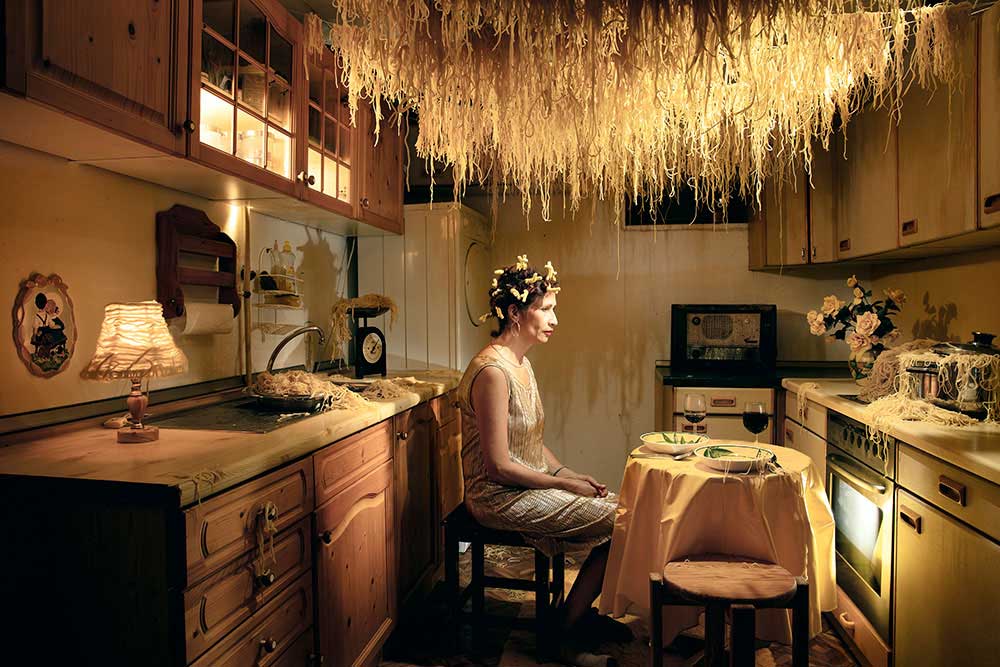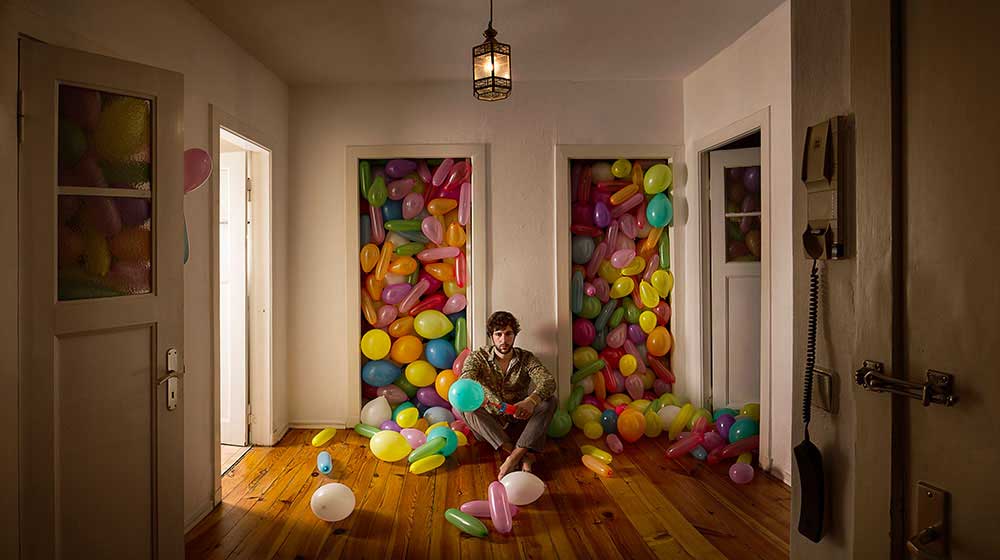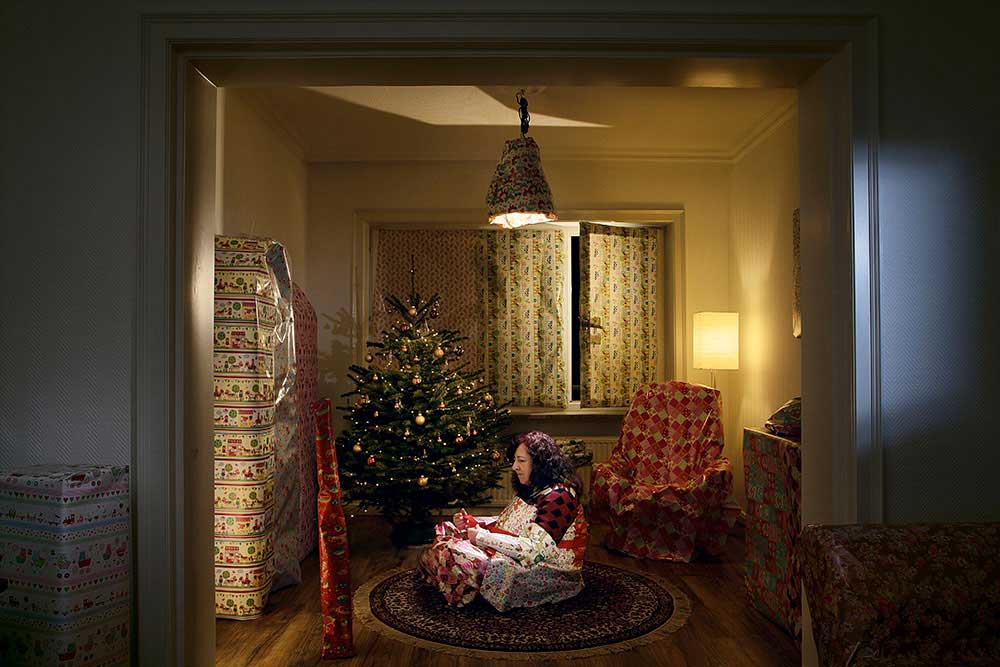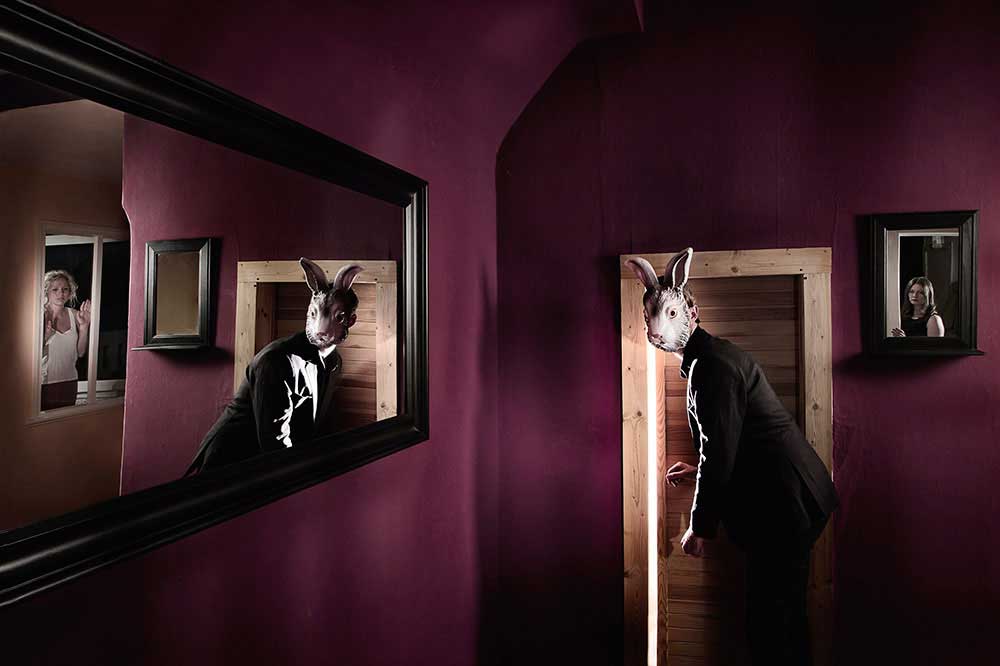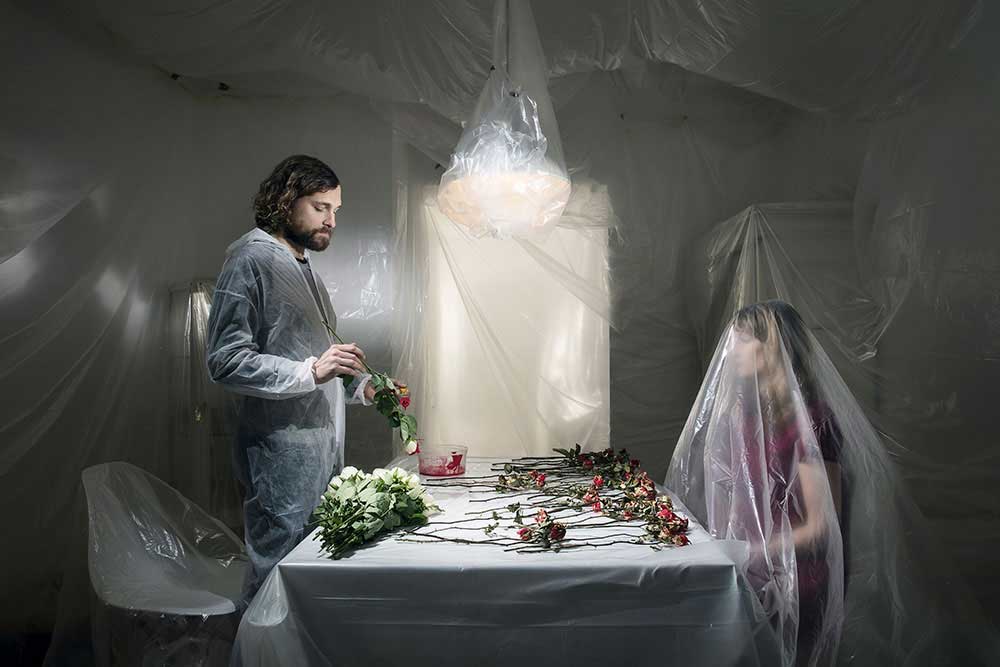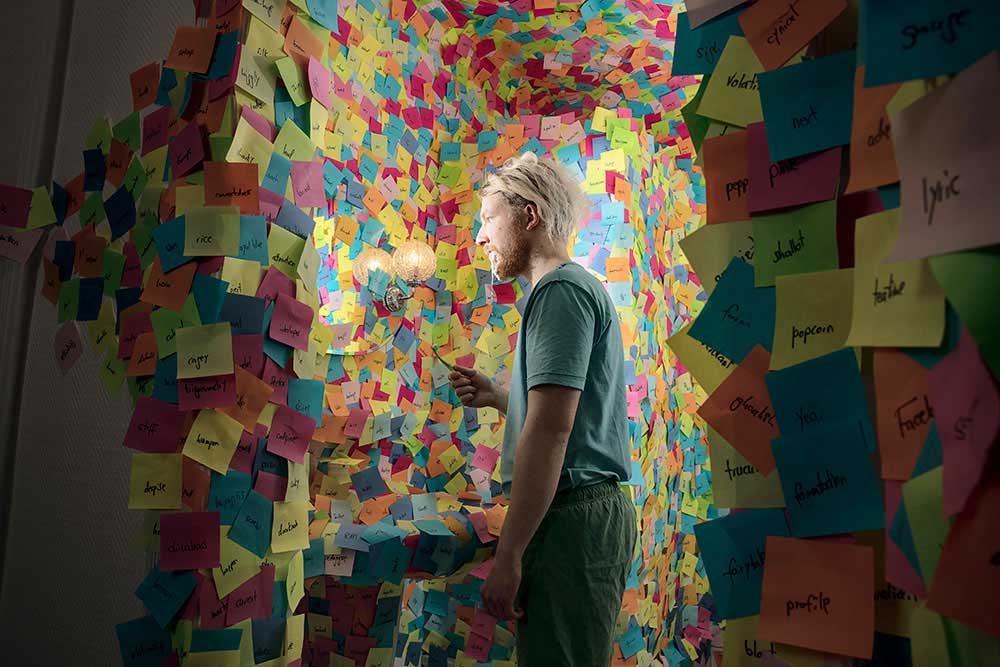Seb Agnew (born 1986) is an award-winning photo artist based in Hamburg, Germany. Within staged images, he creates hyperrealistic sceneries which explore the human psyche and our modern society.
Set design, lighting and composition play a major role in his photographic work. Seb loves cinematic and mysterious settings as well as moments of disorientation and lonesome reflection. Depending on the concept, he transforms whole rooms or builds his locations completely as miniature sets in which he later integrates his life-size models. During his studies of “Audiovisual Media” in Stuttgart, Germany, Seb specialised in photography and post production to lay the foundations of his future work. In order to pass on his skills professionally, he later studied “Vocational Education” at the university of Hamburg, Germany. Today, Seb is excited to be able to work independently as a photo artist and to teach aspiring photographers at the “Vocational School for Media and Communication” in Hamburg, Germany. [Official Website] [Digital Edition] [Print Edition]
I would like to begin this interview by stating that I find the submission of three concepts: ‘Grown – Syncope – Epiphany’ a really fascinating way of conceptualizing your understanding of these elements. My previous interview with a photographer who focused on the ‘staged’ image mainly highlighted political issues. This, however, aims to focus on three very key points during an individual’s life. Have you always been fascinated with investigating the human psyche or has your body of work evolved from a previous genre of photography such as landscape or portraiture?
Human behavior, and psychology in general, have indeed always fascinated me. After graduating from school, I initially even planned to study psychology, but my love for visual media finally led me to photography. Still, human emotions and self-reflection have been a big part of my photographic work from the very beginning. Like every student, I started exploring different genres, but I quickly realized some kind of a pattern in my images: People lost in their own world of thoughts, atmospheric lighting and settings with a of hint of mystery to them. My earliest personal projects were certainly more of a “classic” portrait, but even then, I did not want to highlight the aesthetical part of an image, but concentrate on depicting a person’s inner life and emotions.
Let’s begin with ‘Grown’: as you stated this ‘primarily deals with the border between childhood and adulthood’. There is a sense of mystery surrounding this chapter, especially as you aim to question the difference between both stages of individuality and youthhood as a whole. I find this chapter to be the most enthralling because you aim to question what becomes of early dreams and when we as children begin to change our mentality and adopt an adult way of life … With regards to the images themselves, are the objects you choose to showcase personal to you, or are you simply highlighting objects that coincide with the specific set and protagonists?
I guess you could call these objects universal in a way that most of us had one or more of them in our childhood. This certainly makes it easier for the viewer to identify with the images. When choosing one of these props, the scenery, the context and of course the model definitely play another important role. At the same time, I depicted situations and used objects that are very personal to me. The best example is “Stuffed Animal”. Apart from being the protagonist in this image myself, I used my favourite stuffed animal from my own childhood – which has been stored away in a closet for a long time now. Using it for the image was a mixture of nostalgia and giving it a new purpose at the same time.
Syncope: As previously stated, ‘Grown’ is by far my favourite chapter, yet ‘Syncope’ has to be the most personal to me. After reading the chapter’s description I automatically assumed this was directed for a specific age group. You attempt to tackle the notion of ‘loosing track’ and not being able to find one’s way. This idea of a temporary loss of consciousness is somewhat reflective of the substances that one might take to continue down this path. Syncope therefore takes on a double meaning – the loss of consciousness is perhaps referring to a literal substance abuse as well as a metaphor for losing one’s way in life. Could you tell us a little bit about the process behind these images and how you came about to tackle this idea?
First of all, I have to mention that there was some kind of a natural transition between “Grown” and “Syncope”: After finishing the last image of “Grown” – “Ride-On Car” – I struggled with the idea of keeping on using specific childhood relics for this body of work. I literally had the urge of “moving on”, but could not figure out how until I visited “The Old Operating Theatre” in London – a museum about the history of medicine and surgery in which I accidentally stumbled upon the word “Syncope” (the medical term for “fainting” or “passing out”). A couple of days later, I decided to broaden my perspective within my series: The act of self-reflection, but also the feeling of being lost, is not only linked to the process of growing up, but, in my opinion, is a phenomenon that can be witnessed everywhere nowadays. There is a plethora of stimuli all around us, be it from social media, our jobs or our daily private lives and duties, and this can often make it hard for people – me included – to focus. “Sticky Notes”, as an example, addresses this feeling visually quite directly and plays with the image of how it might look within our heads from time to time.
Epiphany: The culmination of a three-part series. This final chapter so to speak offers a new perspective and, as you stated, is all about revelations. Would you say that both Grown and Syncope are part of a human’s individuality that eventually leads up to a possible realization? Is this three-part series a complete investigation of what you believe to be the process of growing up?
Yes, definitely. As mentioned above, “Grown” suddenly evolved into “Syncope”, even though the underlying concept, or causality, of reflection and realization stays the same. Referring to “Epiphany”, this natural transition from one sub-series to the other happened again lately when I was creating an image I originally intended to become part of “Syncope”: “Antlers”. Immediately after the shooting, I had to discover that the image just didn’t fit into the expected series. I suddenly realized that this image had something different to it – the protagonist is not merely lost in the moment, but gathers new insights (I leave it to the viewer to conclude what these insights might be). Hence, I decided to name this new part of the series “Epiphany”, relating to the famous “Aha!” moment. All in all, I assume that such epiphanies are often considered to happen by accident, but I still strongly believe that they are also – maybe subconsciously –part of a longer psychological process as a human being.
I would like to move from the conceptual side of your photography and discuss the actual process and methodology. Of course, your images are staged and very well executed when focusing on a specific theme or elements. Could you tell us a little about the time it takes to gather the necessary equipment, what you look for when choosing the individuals for each shoot and where these ideas initially come from … Do you begin with an exploration of the idea itself or does the idea behind the image come to you while designing a set?
Every image takes me about four to six weeks to complete. Most of this time is spent on developing the actual idea – a process which I take very seriously and don’t want to rush because that’s the heart of my work. At the same time, I start gathering and preparing the props. Designing the set and lighting it normally takes a couple of days. Due to this rather thorough preparation, the shooting itself can sometimes be finished within a couple of minutes.
Referring to the models of my images, I enjoy working with people that I know, be it friends, family members or recent acquaintances. I always try to match a set with the appropriate protagonist, and, for me, knowing a person facilitates such a decision a lot. Every person has his or her own aura, and I want to be sure that this aura can come to life within the image. It’s not a very scientific or visually driven decision but mostly comes down to my own personal feeling. Even though each of my images is staged, I want the situation to be perceived as authentic.
The individual ideas behind my images can have many origins. As mentioned earlier, I am primarily interested in depicting situations of self-reflection, exploring the human psyche and or our modern society. I try to examine these “leitmotifs” within different bodies of work, always with a different focus. Once I have defined this focus, I start with typical creativity techniques like brainstorming or mind mapping. Sometimes this already leads me to a concrete concept, but mostly I have to work for a long time on a vague idea. In my case, inspiration is deeply connected with investigating everything that happens around me and being very attentive. Sitting in front of a sheet of paper normally doesn’t do the trick for me, I need to be confronted with places and situations. Finding an inspiring scenery by chance can be wonderful, but often I search for places and rooms that either fit an existing idea or I adapt them to my imagination and then combine them with narrative elements. When I’m stuck with an idea, it helps me a lot to go for a long walk or a jog – but also to discuss my thoughts with my wife who is, luckily, always critical and honest with my ideas and a very creative person herself.
Colour seems to be an important factor in each photograph. I feel that colour really adds to the overall tonality of the image and brings the viewer closer to the subject matter itself. Have you ever considered producing a photograph in black and white, or do you believe that the intention behind the image would be lost if converted to a monochromatic medium?
You are right, I concentrate a lot on using specific colours within my work since they contribute so much to the overall atmosphere of a scenery and have such a huge impact on our emotions. Still, the thought of creating a series completely in black and white has already crossed my mind because lighting can convey messages and emotions equally well in my opinion. Sometimes, colours can even distract if not used properly. Film noir is a great example for the psychological and narrative effects lighting can have. Even though my style is certainly characterized by the use of colour at the moment, I’m open to new approaches as long as they support my vision and intention of the series.
Due to the fact that this body of work is ‘Ongoing’, what kind of elements will we be expecting you to tackle in future photographs?
My main focus currently lies on the last episode of this body of work, “Epiphany”. As described before, this sub-series has only just emerged and I am excited to generate scenes which highlight personal “Aha!” moments in life. I don’t want to give away specific elements and ideas yet, so it’s best to come back to my portfolio from time to time by either visiting my website or connecting with me on Instagram. 🙂
Francesco Scalici
A recent MA graduate from the University of Lincoln, Francesco has now focused on landscape photography as the basis of his photographic platform. An author for DODHO magazine, Francesco’s interest in documentary photography has turned to writing and has had various articles, interviews and book reviews published on platforms such as: ‘All About Photo.com’, ‘Float Magazine’ and ‘Life Framer Magazine’. Currently on a photographic internship, Francesco has most recently been involved in the making of a short film titled: ‘No One Else’, directed by Pedro Sanchez Román and produced my Martin Nuza.



